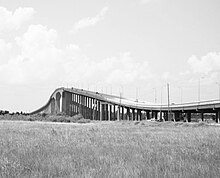Sam Houston Ship Channel Bridge
| Sam Houston Tollway Ship Channel Bridge | |
|---|---|
 |
|
| Coordinates | 29°44′09″N 95°08′46″W / 29.73597°N 95.146227°WCoordinates: 29°44′09″N 95°08′46″W / 29.73597°N 95.146227°W |
| Carries |
|
| Crosses | Houston Ship Channel |
| Locale | Harris County, Texas |
| Maintained by | Texas Turnpike Authority |
| Characteristics | |
| Design | cantilevered concrete trapezoidal haunched hollow box girder bridge |
| Material | concrete |
| Total length | 1,560 feet (480 m) (main bridge) 2 miles (3.2 km) (total length) |
| Width | 59 feet (18 m) |
| Longest span | 750 feet (230 m) |
| Clearance below | 175 feet (53 m) |
| History | |
| Construction start | 1980 |
| Construction end | 1982 |
| Opened | 1982-05-06 |
Sam Houston Tollway Ship Channel Bridge (formerly known as the Jesse H. Jones Memorial Bridge) is a bridge in Harris County, Texas. It was acquired from the then–Texas Turnpike Authority (TTA) (now North Texas Tollway Authority) on May 5, 1994, and is now a part of the Harris County Toll Road Authority system. The bridge opened to traffic in May 1982. It carries four lanes of Beltway 8 over the Houston Ship Channel with a clearance of 175 feet (53 m).
The 1952 City of Houston planning document recommended a second loop designated the Outer Belt. Harris County took control of the project in 1960. Efforts to construct the Beltway 8 crossing started in the mid-1960s, culminating in an effort vetoed by Governor John Connally on June 18, 1967. Voters twice rejected bond funds for the bridge, so the effort was reconstituted as a toll bridge. This did not work at that time.
In 1978, the Texas Turnpike Authority performed a study showing the project as feasible, and sold $102M (approximately $333.1M in 2008) of bonds to fund it.
Among designs looked at, a cable-stayed design was studied, but not sufficiently understood at the time. Such was later used on the Fred Hartman Bridge, but in 1978 when this bridge was designed, the only U.S. example of a cable-stayed bridge was the Ed Hendler Bridge, meaning there was a deficiency of design and construction experience for the bridge type.
Construction completed in 1982 and the bridge was opened on May 6. At the time of completion, the bridge was the longest box girder span in the Western Hemisphere, which record it held until 1997 and the opening of the Confederation Bridge. It is no longer in the top 20 of longest box girder spans.
Traffic volume had been projected to be 4 million vehicles in 1982, but came in at only 1.69 million, a 58-percent shortfall. This was attributed to a lack of connections to the bridge. Additional ramps were completed in 1984, but the results were insufficient to service the bonds. The bonds were refinanced in 1985 at a rate of 12.625 percent (original rate was 7.54 percent), and could not be paid off until July 1, 2002. Total debt service as of the end of 1985 was $522M, with a minimum of $176M.
...
Wikipedia

